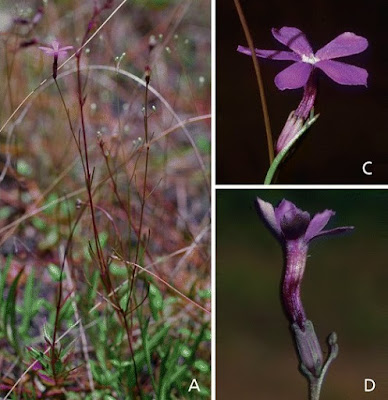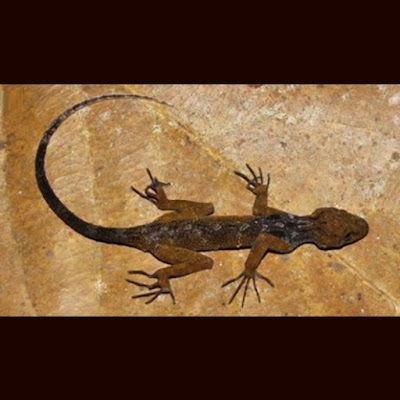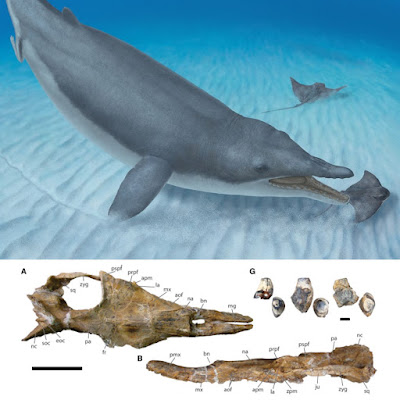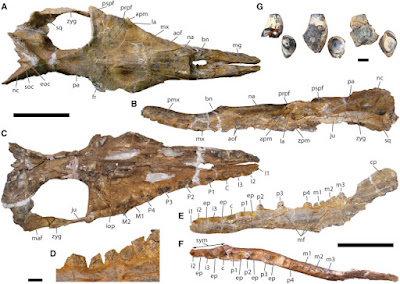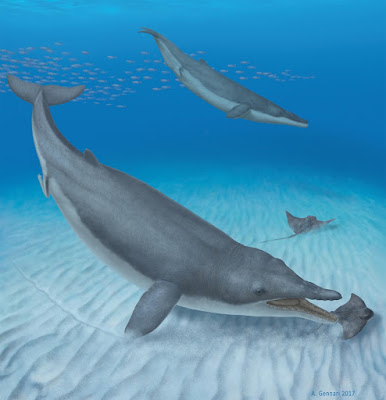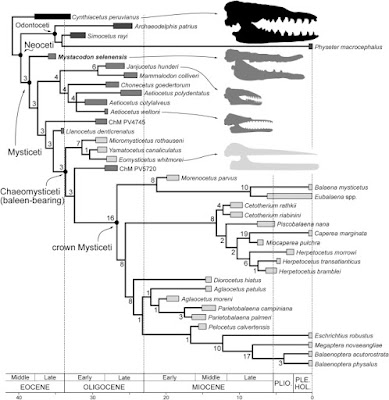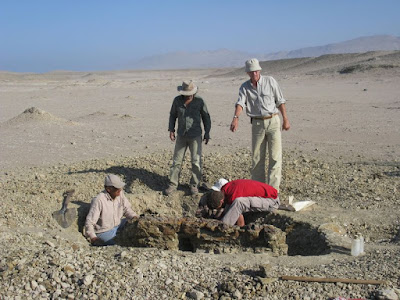[Most Recent Entries] [Calendar View]
Friday, May 12th, 2017
| Time | Event | ||||||
| 8:09a | [Botany • 2017] Buchnera carajasensis • A New Species (Orobanchaceae) from the Canga Vegetation of the Serra dos Carajás, Pará, Brazil
Summary Buchnera carajasensis is described and illustrated. Information on its conservation status, taxonomy, habitat, geographic distribution, and phenology, along with a key to the Buchnera species found in Pará, is provided. The new species had previously been confused with B. tenuissima, a Mexican species, and is also similar to B. palustris, but exhibits differences in the inflorescence shape, in the indumentum, and in reproductive traits. The new species is apparently endemic to ironstone outcrops of the Serra dos Carajás, northern Brazil, and is assessed as Endangered in accordance with the IUCN criteria. Key Words: Amazon, endemism, ironstone outcrops, Scrophulariaceae Buchnera carajasensis Scatigna & N. Mota sp. nov. ETYMOLOGY. The specific epithet refers to the name of the Serra dos Carajás, where the species is believed to be endemic. André Vito Scatigna, Nara Furtado de Oliveira Mota and Pedro Lage Viana. 2017. Buchnera carajasensis (Orobanchaceae), A New Species from the Canga Vegetation of the Serra dos Carajás, Pará, Brazil. Kew Bulletin. 72; 25. DOI: 10.1007/s12225-017-9698-1 | ||||||
| 5:17p | [Herpetology • 2017] Cnemaspis leucura • A New Species of Rock Gecko Genus Cnemaspis (Squamata: Gekkonidae) from Western Sarawak, Malaysia
Abstract A new species of Asian rock gecko, genus Cnemaspis, is described from Padawan, western Sarawak, Malaysian Borneo. The new species forms a clade with C. paripari and C. nigridia of the C. nigridia group in a mitochondrial DNA phylogeny and is similar to them morphologically in some characters such as caudal scalation. It differs from the other Asian Cnemaspis species in its unique combination of snout–vent length (up to 62.7 mm), 4–9 precloacal pores in males, keeled subcaudals with an enlarged, smooth, median row, presence of ventrolateral caudal tubercles, and coloration (head and upper flanks dark-yellow; anterior portion of tail black; posterior portion of tail white with black, paravertebral blob). Phylogenetic relationships within the C. nigridia group and the distributional ranges of species within the group suggest allopatric speciation by geographic isolation. Keywords: Borneo, Gunung Penrissen, sandstone, Cnemaspis nigridia group, Reptilia, Malaysia
Etymology. The specific epithet leucura is from the Greek leukos and oura, meaning white-tailed, referring to white subcaudal color on the posterior part of tail in the male holotype. The generic name is feminine in gender. Distribution. Cnemaspis leucura is known from the montane area of Gunung Penrissen, Kuching District, Sarawak, East Malaysia. Takaki Kurita, Kanto Nishikawa, Masafumi Matsui and Tsutomu Hikida. 2017. A New Species of Rock Gecko Genus Cnemaspis (Squamata: Gekkonidae) from Western Sarawak, Malaysia. Zootaxa. 4258(6); 525–538. DOI: 10.11646/zootaxa.4258.6.2 | ||||||
| 5:23p | [PaleoMammalogy • 2017] Mystacodon selenensis • Earliest Mysticete from the Late Eocene of Peru Sheds New Light on the Origin of Baleen Whales
Highlights • An ancient whale is described based on a skeleton from the late Eocene of Peru • It is identified as the earliest known mysticete (baleen whales and relatives) • Skeletal anatomy provides crucial information on archaeocete-mysticete transition • This whale is interpreted as specialized for suction and possibly benthic feeding Summary Although combined molecular and morphological analyses point to a late middle Eocene (38–39 million years ago) origin for the clade Neoceti (Odontoceti, echolocating toothed whales plus Mysticeti, baleen whales, and relatives), the oldest known mysticete fossil dates from the latest Eocene (about 34 million years ago) of Antarctica. Considering that the latter is not the most stemward mysticete in recent phylogenies and that Oligocene toothed mysticetes display a broad morphological disparity most likely corresponding to contrasted ecological niches, the origin of mysticetes from a basilosaurid ancestor and its drivers are currently poorly understood. Based on an articulated cetacean skeleton from the early late Eocene (Priabonian, around 36.4 million years ago) of the Pisco Basin, Peru, we describe a new archaic tooth-bearing mysticete, Mystacodon selenensis gen. et sp. nov. Being the geologically oldest neocete (crown group cetacean) and the earliest mysticete to branch off described so far, the new taxon is interpreted as morphologically intermediate between basilosaurids and later toothed mysticetes, providing thus crucial information about the anatomy of the skull, forelimb, and innominate at these critical initial stages of mysticete evolution. Major changes in the morphology of the oral apparatus (including tooth wear) and flipper compared to basilosaurids suggest that suction and possibly benthic feeding represented key, early ecological traits accompanying the emergence of modern filter-feeding baleen whales’ ancestors. Systematics Cetacea Pelagiceti Neoceti Mysticeti Mystacodontidae fam. nov. Mystacodon selenensis gen. et sp. nov. Etymology: From ancient Greek mystacos (“moustache”) in reference to the suborder Mysticeti and odontos (“tooth”), “mysticete with teeth,” and from Selene, the Greek goddess of the moon, in reference to the Playa Media Luna type locality.
Holotype: Museo de Historia Natural, Universidad Nacional Mayor de San Marcos (MUSM; Lima, Peru) 1917, partial skeleton including cranium, mandibles, teeth, cervical, thoracic, lumbar and caudal vertebrae, ribs, partial right and left forelimbs, and left innominate. Locality: Playa Media Luna, southern part of Pisco Basin, southern coast of Peru, ... Horizon: Middle part of the Yumaque Formation, 77 m above the base; lower part of calcareous nannofossil zone NP19/20 of Martini; dated at 36.4 million years ago based on age estimations used by Agnini et al. [2014]; early late Eocene (early Priabonian; see Figures S1A and S1D, Table S1, and STAR Methods for the biostratigraphic and biochronological interpretations). Diagnosis: MUSM 1917 is identified as a Neoceti based on the following derived characters, absent in basilosaurid archaeocetes: partly open mesorostral groove; anteroposteriorly elongated rostral portion of maxilla; loss of sagittal crest; supraoccipital shield anterodorsally inclined; apex of zygomatic process of squamosal nearly contacting postorbital process of frontal; and distal epiphysis of the humerus divided in two angled radial and ulnar facets. It can be referred to the Mysticeti due to the following combination of derived characters: dorsoventrally thin lateral edge of maxilla on rostrum; presence of an antorbital process of the maxilla; presence of a maxillary infraorbital plate; and triangular supraoccipital shield. It is further diagnosed by two possibly autapomorphic features: nasal anteroposteriorly longer than frontal plus parietal and strong tuberosity on anterior edge of radius; two additional derived characters: posteriormost upper tooth anterior to level of antorbital process of maxilla and broad-based rostrum (ratio between width of skull at rostrum base and width at postorbital process > 0.8); and a series of plesiomophic features: supraoccipital shield not extending anterior to anterior level of squamosal fossa, only two dorsal infraorbital foramina, a basilosaurid dental formula 3.1.4.2/3.1.4.3, no wide diastemata between posterior cheek teeth, sutured mandibular symphysis, and well-defined acetabulum on innominate. Finally, MUSM 1917 lacks cranial synapomorphies of Odontoceti: facial concavity, presence of premaxillary foramen and premaxillary sac fossa, and posterior expansion of maxilla over the supraorbital region (Figures 1, 2, 3, and S2).
Olivier Lambert, Manuel Martínez-Cáceres, Giovanni Bianucci, Claudio Di Celma, Rodolfo Salas-Gismondi, Etienne Steurbaut, Mario Urbina and Christian de Muizon. 2017. Earliest Mysticete from the Late Eocene of Peru Sheds New Light on the Origin of Baleen Whales. Current Biology. In Press. DOI: 10.1016/j.cub.2017.04.026 36m-year-old fossil discovery is missing link in whale evolution, say researchers TheGuardian.com/science/2017/may/11/36m-y Baleen whales' ancestors were toothy suction feeders http://phy.so/413697728 via @physorg_com This ancient whale likely sucked prey into its mouth like a giant vacuum cleaner https://www.theverge.com/tldr/2017/5/11/1 |
| << Previous Day |
2017/05/12 [Calendar] |
Next Day >> |
